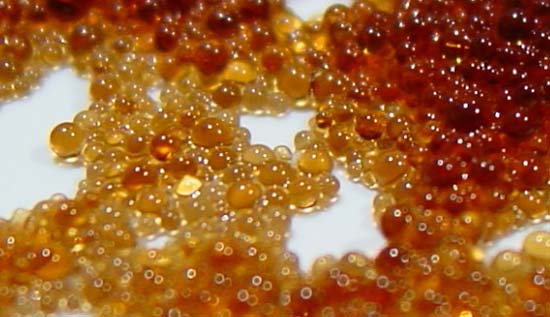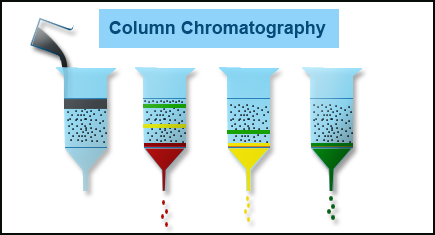Ion exchange chromatography – Overview

What is ion exchange chromatography?
Ion-exchange chromatography (IEC) is an important analytical technique that is frequently utilized for the separation and determination of ions and polar molecules on the basis of their affinity towards the ion exchanger.
Here, Stationary phase = A resin; Mobile phase = An eluent
Ion exchange chromatography along with the ion partition/interaction and ion-exclusion chromatography is an important component of ion chromatography.
Ion exchange chromatography is applicable for various charged molecules such as large proteins, amino acids, and small nucleotides.
Ion exchange chromatography principle
The principle of separation is based on the reversible exchange of ions between the ions present in the sample and those available in the ion exchange resin. Mainly, ion exchange separations take place in a column covered with an ion exchanger.
Forms of Ion Exchange Chromatography
Based on the charge on the ion-exchange ligands, Ion exchange chromatography is divided into two major types:
Anion exchange chromatography
Anion exchange chromatography utilizes a positively charged ion exchange resin that has an affinity towards overall negative surface charge molecules.
Cation exchange chromatography
In cation exchange chromatography, a negatively charged ion exchange resin is utilized that has an affinity towards molecules with overall positive surface charges.
Cation vs anion exchange chromatography:
| Similarity | Dissimilarity |
| Cation exchange chromatography, as well as Anion exchange chromatography, can be employed for both preparative and analytical purposes. They also can segregate a large number of molecules from amino acids and nucleotides to large proteins. | Cation exchange chromatography is mainly used for proteins that possess a net positive charge at a pH below their isoelectric point to be bound. On the other hand, Anion exchange chromatography is used for proteins with a net negative charge at a pH above their isoelectric point to be bound. |
Instrumentation of Ion exchange chromatography
A typical ion exchange column chromatography comprises of:
- Pump – A high-pressure pump is considered as one of the main parts of the Ion exchange chromatography system which delivers a constant flow of the eluent.
- Injector – Amongst the various ways for sample introduction into the eluent stream and onto the column, the most straightforward method being the use of an injection valve.
- Columns – Depending on the area of application, a column is selected for the separation of the sample mixture. Columns being utilized in the laboratories are built from glass whereas the columns utilized in industries are either fabricated from high-quality stainless steel or polymer.
- Oven (optional)
- Detector – This estimates the analyte peaks as eluent from the column
- Data System – This aid in the collection and assembling of the chromatograms and data.
Figure: A systematic ion exchange chromatography diagram; Image courtesy: uspbpep.com
- Packing of the column – The process of ion exchange separations generally takes place in columns that are packed with an ion-exchanger.
The ionic exchangers are formed of styrene and divinylbenzene. An example of an anionic exchanger is DEAE-cellulose whereas an example of a cationic exchanger is CM-cellulose.
- Application of the sample – As soon as the column is packed, on the top of the column the solution to be determined is placed and allowed to pass across the bed of the ion exchanger with the help of a syringe or pipette.
- Developments of the chromatogram and ion exchange chromatography elution – With the aid of different mobile phases such as phosphate buffers, acetate buffers, pyridine buffers, 1N NaOH, etc., the chromatogram is developed.
There are two types of ion exchange chromatography elution techniques utilized namely:
- Isocratic elution – Here, acids or alkalis or buffers of similar strength are utilized.
- Gradient elution – At first, a less acidic or basic mobile phase is utilized. Afterward, at regular intervals, there is an increase in acidity or basicity.
- Analysis of the elute or Detection – Considering the volume or time, different fractions of the elution are collected and analyzed for their contents. Based on the nature and quantity of the ionic species, several methods of analysis are employed such as:
- U.V. Spectroscopy
- Conductometric method
- Flame photometric method
- Polarography
In ion exchange chromatography, a conductivity detector is regarded as the most common and beneficial detector. Finally, the result received is reserved.
- Regeneration – After separation, the ion exchange resin may not be fruitful for the next separation experiment but is not supposed to be disposed of because of its cost. Therefore, it is crucial to reactivate, regenerate the used resins which makes them as efficient as virgin resins.
Applications of ion exchange chromatography
- Ion exchange chromatography is a powerful and critical tool for pharmaceutical analytical chemists.
- Ion exchange chromatography is used for the estimation and separation of molecules with different charges or ions that include proteins, peptides, amino acids, vitamins, carbohydrates, enzymes, etc. either on its own or along with other chromatographic techniques.
- This is also applicable for segregating and purifying organic molecules from natural sources.
- Various molecules with high capacity are also analyzed.
- Desired molecules are purified at high levels.
- At a low cost, the ion exchange chromatography technique is applicable to get transferred to the manufacturing scales.
- The nonsolvent extractable natural products can be followed up.
- It plays an important role in modern drug discovery for isolating natural products.
What are the disadvantages of ion exchange chromatography?
- Through the ion exchange chromatography separation is possible of charged molecules only.
- There is a Buffer requirement
- In the ion exchange column chromatography, the efficiency of the column is less
- After repeated use, it becomes difficult to predict the stability and reproducibility of columns
- Many a time it is difficult to have control over selectivity and resolution
Sources:
- https://www.intechopen.com/books/column-chromatography/ion-exchange-chromatography-and-its-applications
- https://biochemden.com/ion-exchange-chromatography/#Principle_of_Ion-exchange_Chromatography
- https://microbenotes.com/ion-exchange-chromatography/#applications-of-ion-exchange-chromatography
- https://pubmed.ncbi.nlm.nih.gov/14970550/




HI